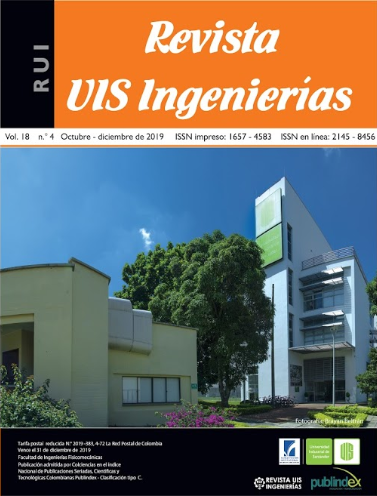SAMI: Serious videogame of bovine cattle farms in Unity supported in System Dynamics
Published 2019-07-16
Keywords
- SAMI,
- Bovine Cattle Farms,
- Serious videogame,
- Unity,
- System Dynamics
How to Cite
Copyright (c) 2019 Revista UIS Ingenierías

This work is licensed under a Creative Commons Attribution-NoDerivatives 4.0 International License.
Abstract
SAMI is a video game for learning about bovine cattle production systems. The game is developed with Unity Engine and has rules based on a model implemented with System Dynamics. On each game, the player must take decisions and do actions that allow him to properly run a farm. Those actions are stored in a website which provides feedback by comparing the executed actions with those which are ideal in order to ease the learning process. The article presents the main aspects of the proposal; that is, part of the model in which it is supported and a summary of the main aspects of implementation in Unity.
Downloads
References
[2] C. J. C. Phillips and D. N. M. George, Principios de producción bovina. Acribia Editorial, 2003.
[3] H. Andrade, I. Dyner, A. Espinosa, H. López, and R. Sotaquirá, “Pensamiento sistémico: diversidad en búsqueda de unidad,” Universidad Industrial de Santander, 2001.
[4] D. W. Ibarra Vega and J. M. Redondo, “Dinámica De Sistemas, Una Herramienta Para La Educación Ambiental En Ingeniería,” Rev. Luna Azul, vol. 41, pp. 152–164, Jul. 2015.
[5] E. Pineda-Ballesteros, A. R. Lizcano-Dallos, and R. N. Lizcano-Reyes, “Redes sociales y representación de conocimiento como apoyo a los procesos de aprendizaje Social networks and knowledge representation as a support of learning processes,” Rev. UIS Ing., vol. 11, no. 2, pp. 237–252, 2012.
[6] A. Wein and W. Labiosa, “Serious games experiment toward agent-based simulation,” Reston, VA, 2013.
[7] B. Gros Salvat, “Certezas e interrogantes acerca del uso de los videojuegos para el aprendizaje,” Rev. Int. Comun. Audiovisual, Public. y Estud. Cult., vol. 7, pp. 251–264, 2009.
[8] T. M. Connolly, E. A. Boyle, E. MacArthur, T. Hainey, and J. M. Boyle, “A systematic literature review of empirical evidence on computer games and serious games,” Comput. Educ., vol. 59, no. 2, pp. 661–686, Sep. 2012, doi: 10.1016/j.compedu.2012.03.004.
[9] M. Qian and K. R. Clark, “Game-based Learning and 21st century skills: A review of recent research,” Comput. Human Behav., vol. 63, pp. 50–58, Oct. 2016, doi:10.1016/j.chb.2016.05.023.
[10] C. López Raventós, “El videojuego como herramienta educativa. Posibilidades y problemáticas acerca de los serious games,” Apertura. Rev. innovación Educ., vol. 8, no. 1, 2016.
[11] U. E. Gómez Prada and O. Gómez S, “Simulation of cattle farms with System Dynamics in a serious videogame. Case: SAMI,” in Big DSS Agro 2017 (I Internacional Conference on Agro BigData and Decision Support systems in Agriculture), pp. 111–114.
[12] U. E. Gómez, H. H. Andrade, and C. A. Vásquez, “Lineamientos Metodológicos para construir Ambientes de Aprendizaje en Sistemas Productivos Agropecuarios soportados en Dinámica de Sistemas ,” Información tecnológica , vol. 26. scielocl , pp. 125–136, 2015.
[13] G. Méndez, E. Obviedo, G. Fallas, C. Vega, and A. Méndez, “Análisis de las herramientas Unity y Blender para el desarrollo de videojuegos con un enfoque educativo,” in V congreso de computación para el Desarrollo (COMPDES), 2012.
[14] H. Bolívar, J. Trocóniz, and A. Ruiz, “Diseño Y Evaluación De Una Estructura De Costos De La Ganadería Bovina En El Estado Barinas, Venezuela Design And Evaluation Of A Cost Structure Of Bovine Raising In Barinas State, Venezuela Ciencias Básicas Y Tecnología,” Saber, vol. 28, no. 4, pp. 761–774, 2016.
[15] J. J. Moreno-Chaustre, H. H. Andrade-Sosa, J. R. García-González, U. Hernández-Pino, G. P. Maestre-Góngora, and G. López-Mólina, “Modelo de evaluación para valorar el cambio en las prácticas docentes con TIC. (Spanish),” Rev. UIS Ing., vol. 13, no. 1, pp. 7–22, 2014, doi: 10.1016/j.sbspro.2012.05.139.
